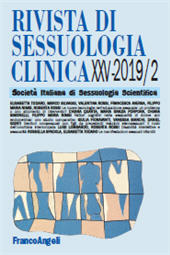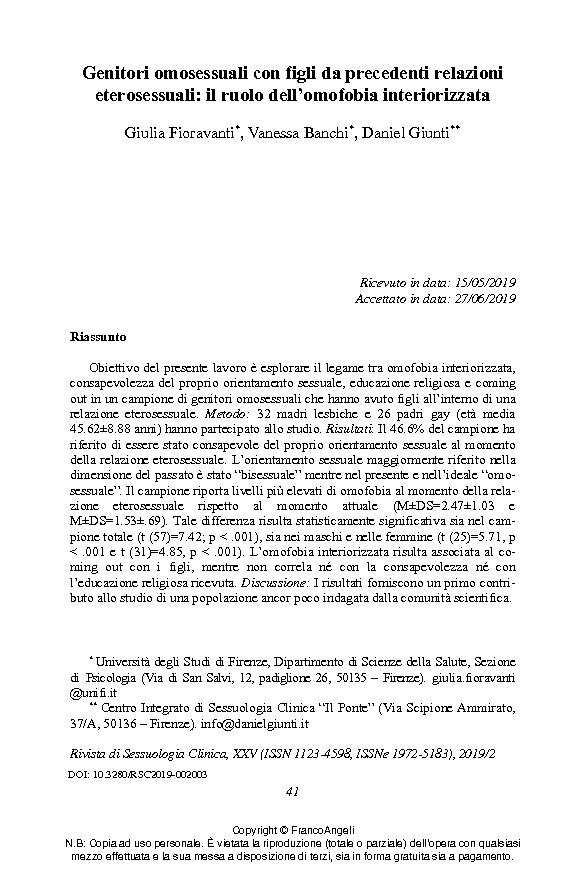Genitori omosessuali con figli da precedenti relazioni eterosessuali : il ruolo dell'omofobia interiorizzata
41-61 p.
Obiettivo del presente lavoro è esplorare il legame tra omofobia interiorizzata, consapevolezza del proprio orientamento sessuale, educazione religiosa e coming out in un campione di genitori omosessuali che hanno avuto figli all'interno di una relazione eterosessuale. Metodo: 32 madri lesbiche e 26 padri gay (età media 45.62±8.88 anni) hanno partecipato allo studio. Risultati: Il 46.6% del campione ha riferito di essere stato consapevole del proprio orientamento sessuale al momento della relazione eterosessuale. L'orientamento sessuale maggiormente riferito nella dimensione del passato è stato "bisessuale" mentre nel presente e nell'ideale "omosessuale". Il campione riporta livelli più elevati di omofobia al momento della relazione eterosessuale rispetto al momento attuale (M±DS=2.47±1.03 e M±DS=1.53±.69). Tale differenza risulta statisticamente significativa sia nel campione totale (t (57)=7.42; p < .001), sia nei maschi e nelle femmine (t (25)=5.71, p < .001 e t (31)=4.85, p < .001).
L'omofobia interiorizzata risulta associata al coming out con i figli, mentre non correla né con la consapevolezza né con l'educazione religiosa ricevuta. Discussione: I risultati forniscono un primo contributo allo studio di una popolazione ancor poco indagata dalla comunità scientifica. [Testo dell'editore].
In Italy, homosexual people are not allowed to adopt a child or to perform donor insemination/surrogacy, thus they become parents mainly in the context of previous heterosexual relationships (Barbagli, Colombo, 2007). Data from the Italian Superior Sanity Institute on 7000 homosexual individuals (2006) revealed that 18% of gay men and 21% of lesbians were parents. Despite their growing diffusion, mixedoriented marriages (i.e. same sex attracted people who are or weremarried with opposite sex partners) are still scarcely investigated by the scientific community. Previous international studies (Higgins, 2004; 2006) have tried to identify possible explanations for the phenomenon, evidencing an important role for internalized homophobia the homosexual individual's negative feelings and attitudes toward homosexuality. However, this topic has not been previously investigated in Italy. The aim of the present study is to explore the association between internalized homophobia,
awareness of sexual orientation religious education and coming out in a sample of Italian homosexual parents with children from previous heterosexual relationships. Method: Participants were recruited through the email lists of Rete Genitori Rainbow and Famiglie Arcobaleno, two voluntary associations of Italian homosexual and bisexual parents. 32 lesbian mothers and 26 gay fathers (mean age 45.62 ± 8.88 years) participated in the study. Information about past and current relationship status, awareness of sexual orientation at the time of marriage, coming out and religious education were collected. Sexual orientation was measured both through the Kinsey Scale (Kinsey Pomeroy e Martin, 1948) and the Modified Klein Sexual Orientation Grid (MKSOG) (Moore, 2000). MKSOG assesses seven domains of human sexuality (i.e. sexual attraction, behavior, and fantasies, emotional and social preference, lifestyle as well as selfidentification) at three different points of measurement (past, present, and ideal), thus
sexual orientation than the onedimensional Kinsey Scale. Internalized homophobia at the time of marriage and at the present time was assessed through the Measure of Internalized Sexual Stigma for Lesbian and Gay Men (MISSLG) (Lingiardi, Baiocco e Nardelli, 2012). Results: Most of the sample (79.3%) has been married with the opposite sex partner (marriage mean duration: 14.16 ± 6.98 years). 13.8% of the participants is still in a heterosexual relationship, while 69% has currently a same sex partner (relationship mean duration: 4.62 ±4.48 years). 46.6% of the participants were aware of their homosexual orientation when they entered into the heterosexual relationship in which they become parents. Sexual orientation has been found to change from the past time to the present time, both in men and in women. While half of the sample reported a "bisexual" sexual orientation in the past, most of the sample (75.90%) described themselves as "homosexual" at the present time. Noteworthy, 32.80% of the participants
defined themselves as "heterosexual" at the time of marriage. Gender differences were found in internalized homophobia levels with men reported higher scores than women, both at the time of marriage and at the present time. Participants reported higher levels of internalized homophobia at the time of the heterosexual relationship compared to the present time (M±SD=2.47±1.03 and M±SD=1.53±.69). This difference was statistically significant both in the total sample (t (57)=7.42; p < .001), and in males and females (t (25)=5.71, p < .001; t (31)=4.85, p < .001). Internalized homophobia is associated with coming out with children, while it did not correlate with awareness of sexual orientation and religious education. Parents who have not declared their sexual orientation to their children reported higher levels of internalized homophobia relative to parents who came out with their children (M±SD=2.16±1.07, M±SD=1.32±.33 respectively, t (56)= 4.58 p < .001).
Discussion: The current results provide a first contribution to the study of a specific population, still scarcely investigated by the scientific community. In line with previous studies (Higgins, 2004; 2006) internalized homophobia decreased from the time of marriage to the present time, suggesting its possible role in the phenomenon of mixedoriented marriages. Moreover, internalized homophobia resulted to be an obstacle for the coming out process with children. Present findings can help health care professionals and therapists to become aware of the influence that internalized homophobia has on gay and lesbian parents' lives. The investigation of this aspect can help individuals to achieve greater selfacceptance and, consequently, better psychological wellbeing. [Publisher's text].
Fa parte di
Rivista di sessuologia clinica : 2, 2019-
Articoli dello stesso fascicolo (disponibili singolarmente)
-
Informazioni
Codice DOI: 10.3280/RSC2019-002003
ISSN: 1972-5183
MATERIE
PAROLE CHIAVE
- Omosessualità, padri gay, madri lesbiche, orientamento sessuale, coming out, omofobia interiorizzata
- Homosexuality, gay fathers, lesbian mothers, sexual orientation, com-ing out, internalized homophobia



